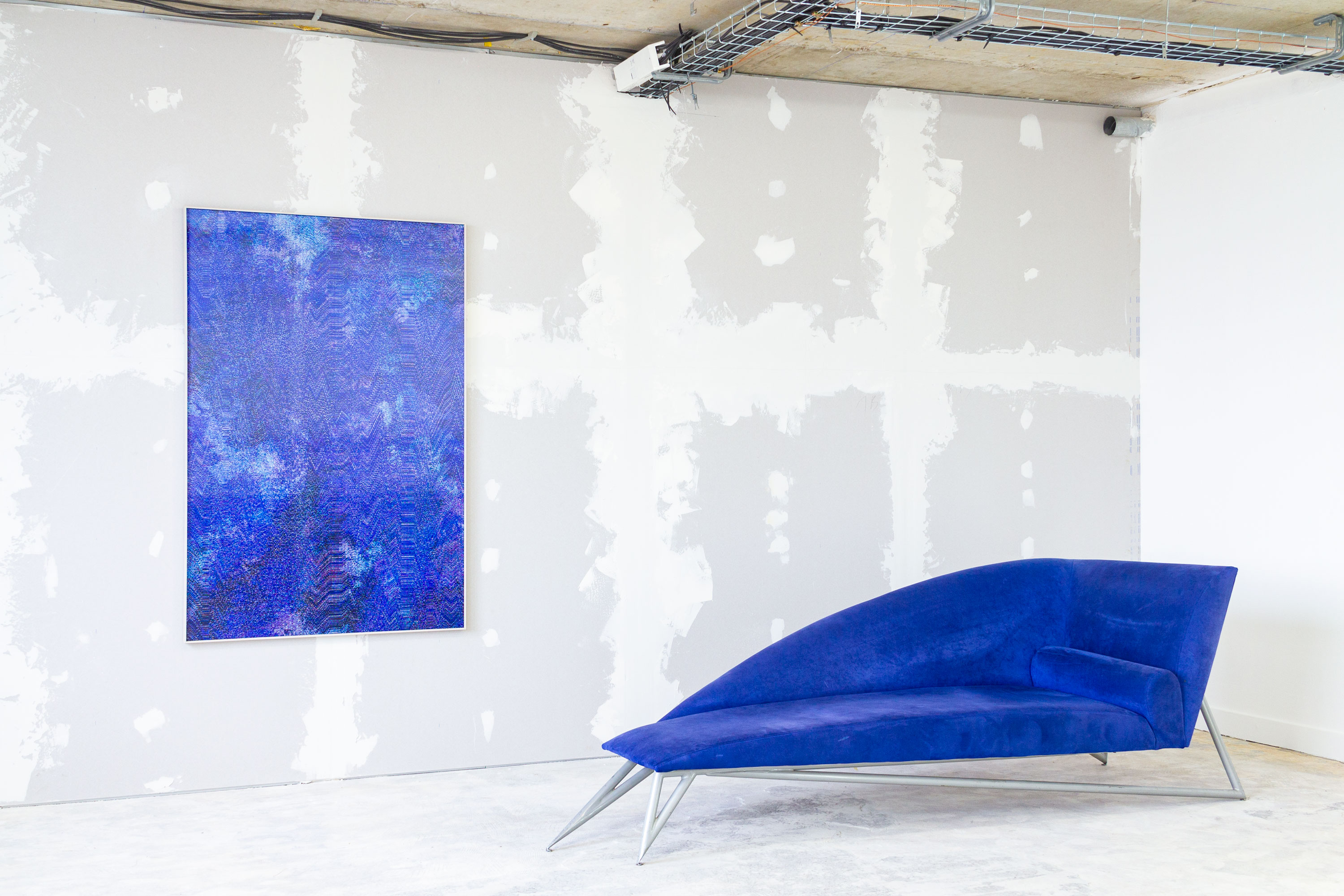
On SCREEN
An homage to Furniture SculptureCurated by
Paul Bourdet & Mathieu Merlet Briand
Online Opening
Tuesday, November 17th, 2020 at 2PM
Photo by Mathieu Merlet Briand
Text by Paul Bourdet
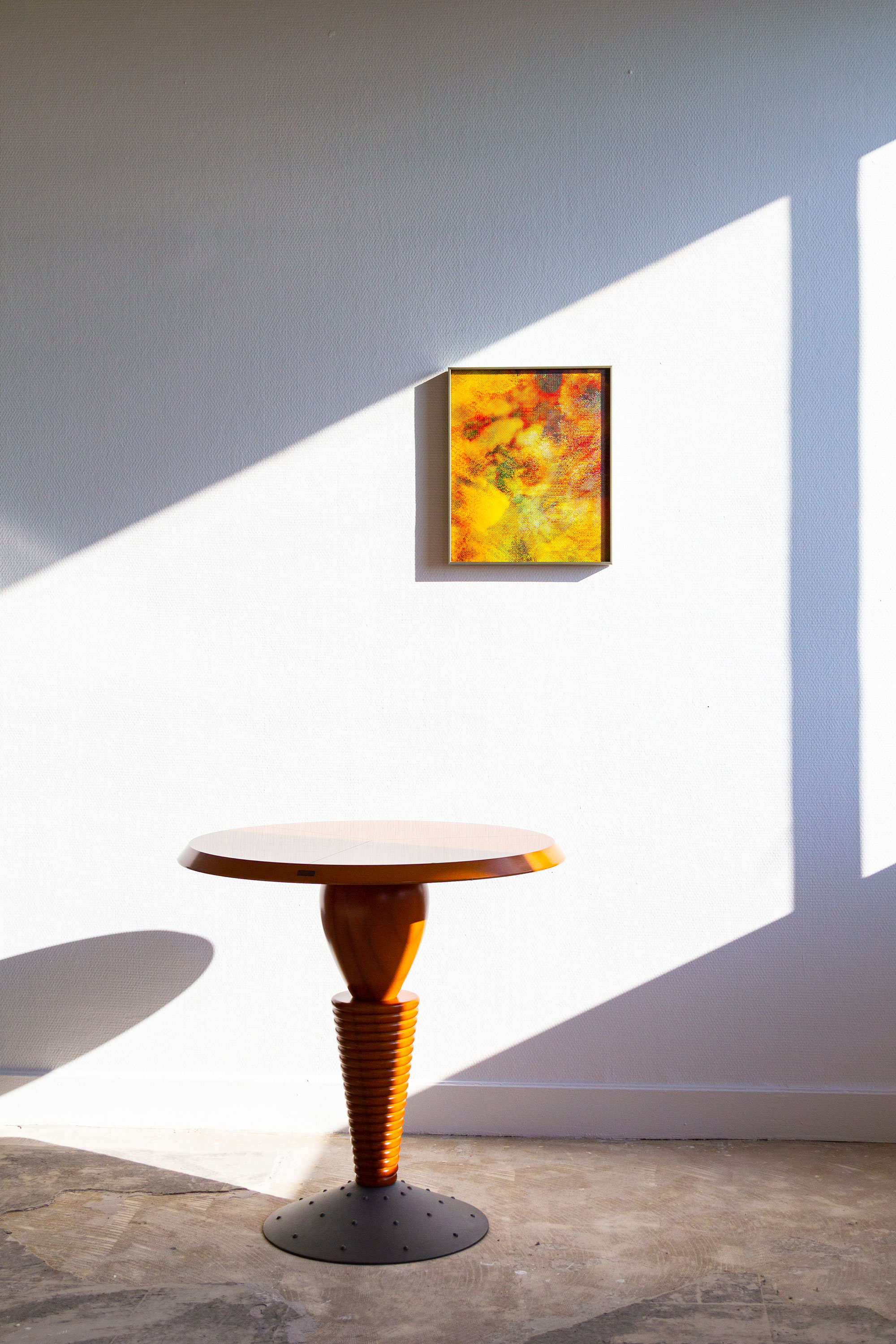
My friend Mathieu Merlet Briand and I were planning a show together to finally celebrate the end of this tremendous year that is 2020. But as predictable as this was, we were caught up by the current medical context leading to the second French lockdown. So, we decided to turn this project into a fictive exhibition only viewable on screen, and to adapt the content and curatorial process to this purpose. The show is hosted on Mathieu’s website and unveiled through Instagram day after day. Mathieu, an Artist fond of 1980s Furniture and myself a Contemporary Art lover 1980s Furniture dealer.
—
Mon ami Mathieu Merlet Briand et moi prévoyions une exposition à quatre mains pour célébrer la fin de cette étrange année 2020. Aussi prévisible que cela pouvait l’être, le contexte médical actuel et le second confinement français nous ont rattrapé. Il est alors apparu comme évident qu’il nous fallait profiter de cette opportunité pour transformer le projet en une exposition fictive visible sur écrans et ainsi adapter le contenu et la curation aux supports digitaux. L’exposition sera présentée sur le site internet de Mathieu et dévoilée jour après jour via Instagram. Mathieu est un artiste contemporain passionné de mobilier années 80, moi un antiquaire spécialisé dans les années 80 et passionné d’art contemporain.
—
• Mathieu Merlet Briand, #SUNFLOWER study I, 2020.
• Philippe Starck, Guéridon Miss Asahi, Ca. 1990, Ed. Idee.
–––––
A few months ago, Mathieu started collecting 1980s Furniture and it quickly became obvious that we had to do something together and to merge our works and passions. Since this exhibition could not take place in a gallery or any kind of public spaces we decided to bring Furniture to Mathieu’s Parisian studio to shoot his works and my pieces together. This exhibition will never be seen physically, except by ourselves, so we did our best to produce images that show faithfully how it could have looked. Trying to set-up small composition showing how an artist can live and evolve with Design pieces in his studio being inspired by them.
—
Il y a quelques-mois, lorsque Mathieu a commencé à collectionner le mobilier 80, l’idée d’une exposition commune combinant notre travail et nos passions s’est assez vite imposée. Cette exposition ne pouvant avoir lieu dans une galerie ou n’importe quel espace public, nous avons décidé de présenter du mobilier dans l’atelier de Mathieu pour le photographier avec ses œuvres. Étant donné que cette exposition ne sera jamais vue physiquement, excepté par nous, nous avons tenté de produire des images traduisant le plus fidèlement possible ce à quoi elle aurait pu ressembler. Nous avons créé des compositions montrant comment un artiste dans son studio peut vivre et évoluer avec des pièces de mobilier tout en étant inspiré par celles-ci.
—
• Mathieu Merlet Briand, #PANSY study II, 2020.
• Philippe Starck, Lampe Easylight, Ca. 1979, Ed. Electrorama.
• Philippe Starck, Chaise Miss Milch, Ca. 1987, Ed. Idee.
–––––
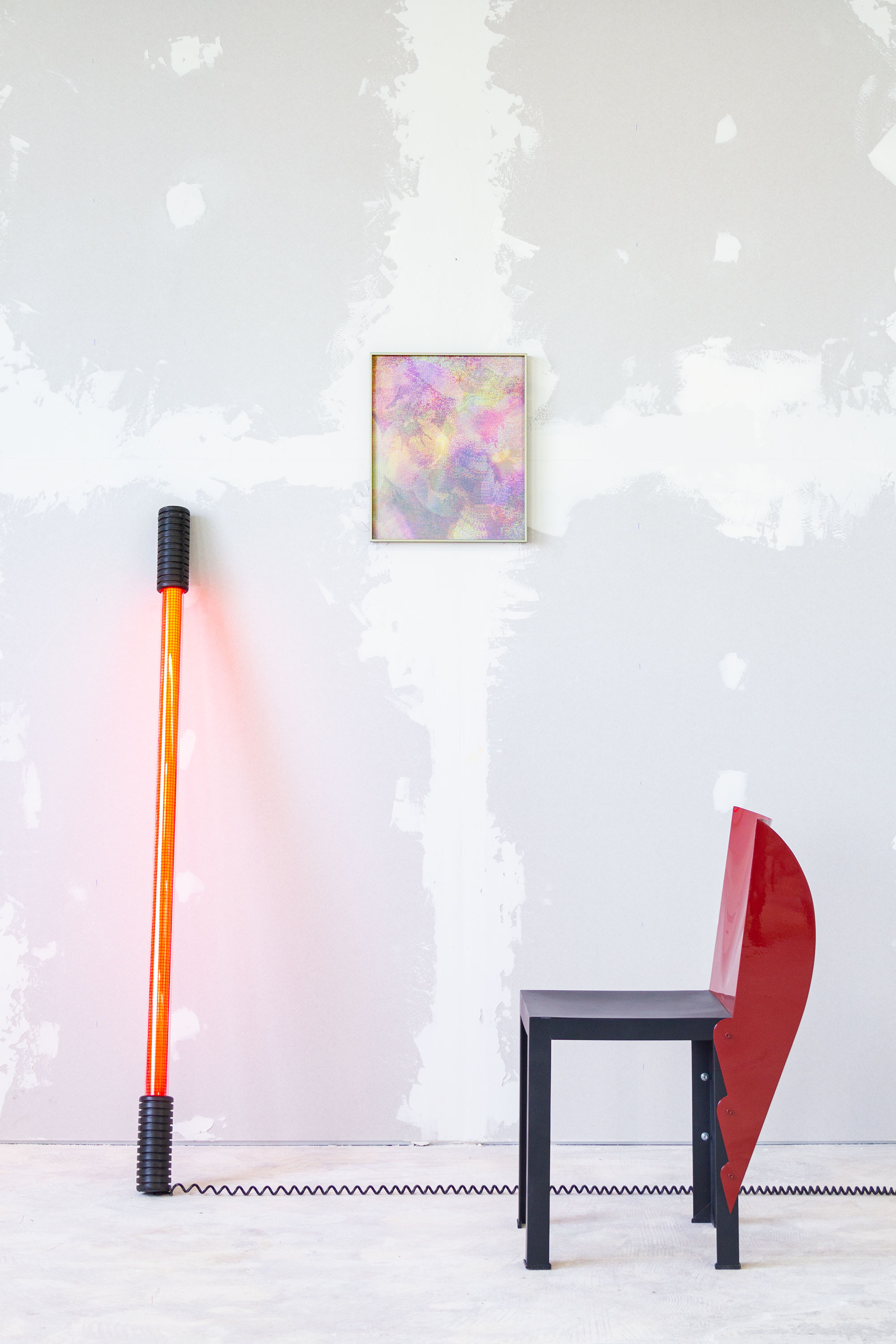
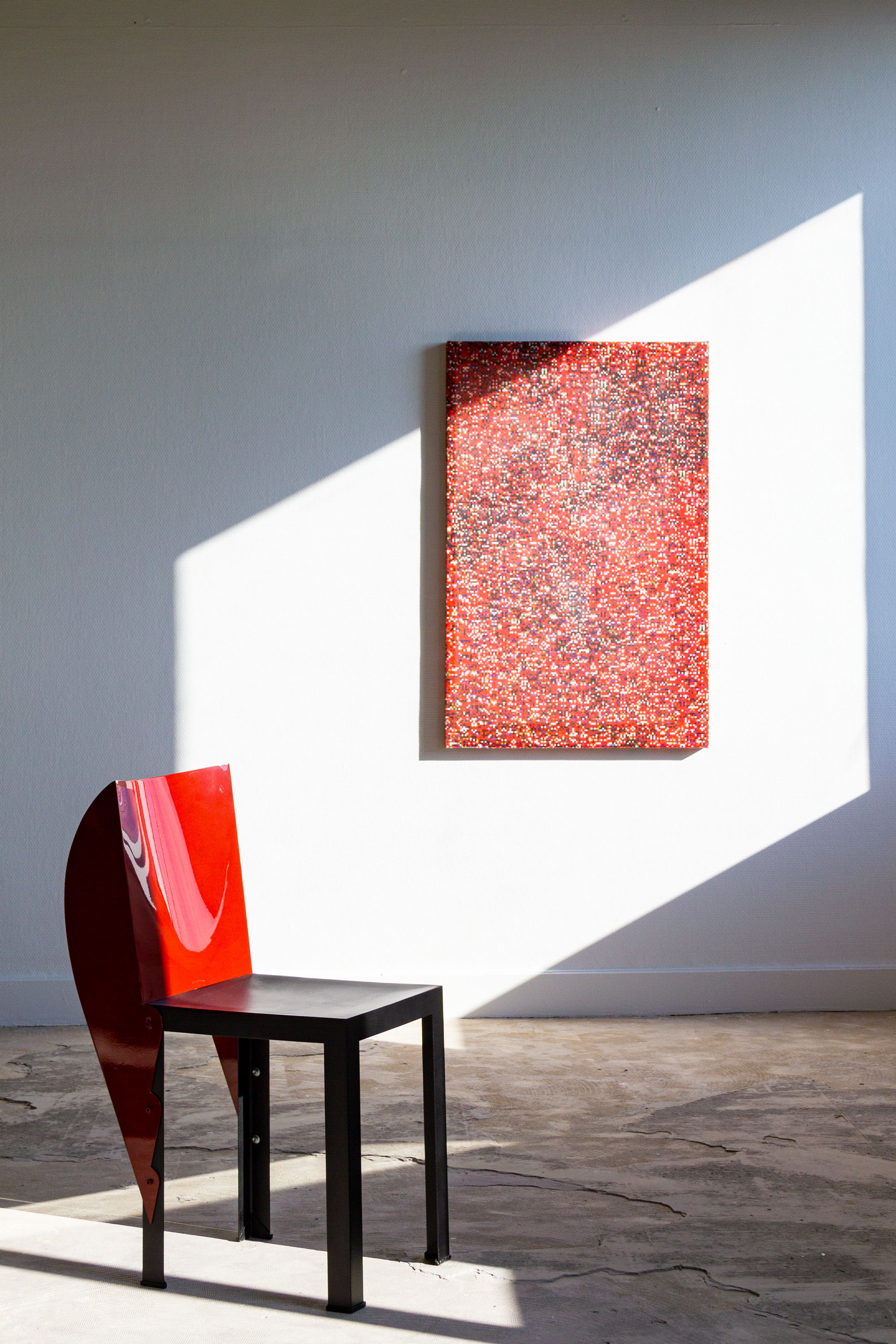
• Mathieu Merlet Briand, Memories of the #RED-SCREEN Temple, 2018.
• Philippe Starck, Chaise Miss Milch,Ca. 1987, Ed. Idee.
–––––

The idea was not to pretend that Design is Art or that Art has a decorative purpose but to highlight the fact that there is a strong synergy between both. Artworks and Furniture pieces both being creations of the mind, even if not responding to the same creative process, can dialogue together and complement each-others. These images can be seen as a tribute to John Armleder’s concept of “Furniture Sculpture” which has strongly influenced Mathieu’s artistic practice over the years. Having studied Product Design at Ecole des Arts Décoratifs in Paris, Mathieu started, as a graduation project, by designing stools made of recycled foam to later recycle images found on the Internet to create abstract compositions.
—
L’idée n’était pas de prétendre que Design égal Art ou que l’Art a une portée décorative, mais de mettre en lumière la synergie qui existe entre ces deux pratiques. Œuvres d’Art et pièces de mobilier étant toutes deux des créations de l’esprit, bien que ne répondant pas au même processus créatif, peuvent dialoguer entre elles et se compléter. Ces images peuvent être considérées comme un hommage à John Armleder et son concept de « Furniture Sculpture » qui a influencé le travail de Mathieu depuis des années. Ayant étudié le Design Produit à l’École des Arts Décoratifs de Paris, Mathieu a débuté, dans le cadre de son projet de fin d’études, en produisant des tabourets en mousse recyclée pour plus tard recycler des images dénichées sur le web afin de créer des compositions abstraites.
— • Mathieu Merlet Briand, #WATERLILIES, 2020.
• Jean-Michel Wilmotte, Fauteuil Compas, Ca. 1984, Ed. Academy.
• Xavier Matégot, Table XM, Ca. 1986, Ed. Christian Farjon.
–––––
In this project, the Furniture and Artworks that are featured end up creating a whole picture and should not be considered autonomously. Through this we tried to humanize the Artworks and to present them in a less abstract context than the typical white cube, closer to the collector home where they should finally be hanged. The Design pieces are by 1980s French designers including Philippe Starck, Jean-Michel Wilmotte, Nemo, Jean-Louis Godivier, Xavier Matégot & Ronald-Cecil Sportes. The Artworks featured were created between 2012 and 2020 which gives an overview of Mathieu’s body of work.
—
Au fil des compositions, les œuvres et pièces de mobilier présentées dans ce projet forment une image globale et ne doivent plus être considérées de manière autonome. A travers cela nous avons tenté d’humaniser les œuvres en les présentant dans un environnement moins abstrait que l’habituel white cube, plus proche de l’intérieur de collectionneur dans lequel elles finiront par être accrochées. Les pièces de Design ont été dessinées par des créateurs français des années 80 parmi lesquels Philippe Starck, Jean-Michel Wilmotte, Nemo, Jean-Louis Godivier, Xavier Matégot et Ronald-Cecil Sportes. Les œuvres d’Art présentées ont été créées entre 2012 et 2020 ce qui offre une vision globale du travail de Mathieu.
—• Mathieu Merlet Briand, #ORANGE-SCREEN, 2018. • Philippe Starck, Guéridon Miss Asahi, Ca. 1990, Ed. Idee.
–––––


• Mathieu Merlet Briand, #ORANGE-SCREEN, 2018.
• Philippe Starck, Guéridon Miss Asahi, Ca. 1990, Ed. Idee.
• Philippe Starck, Lampe Easylight, Ca. 1979, Ed. Electrorama.
–––––
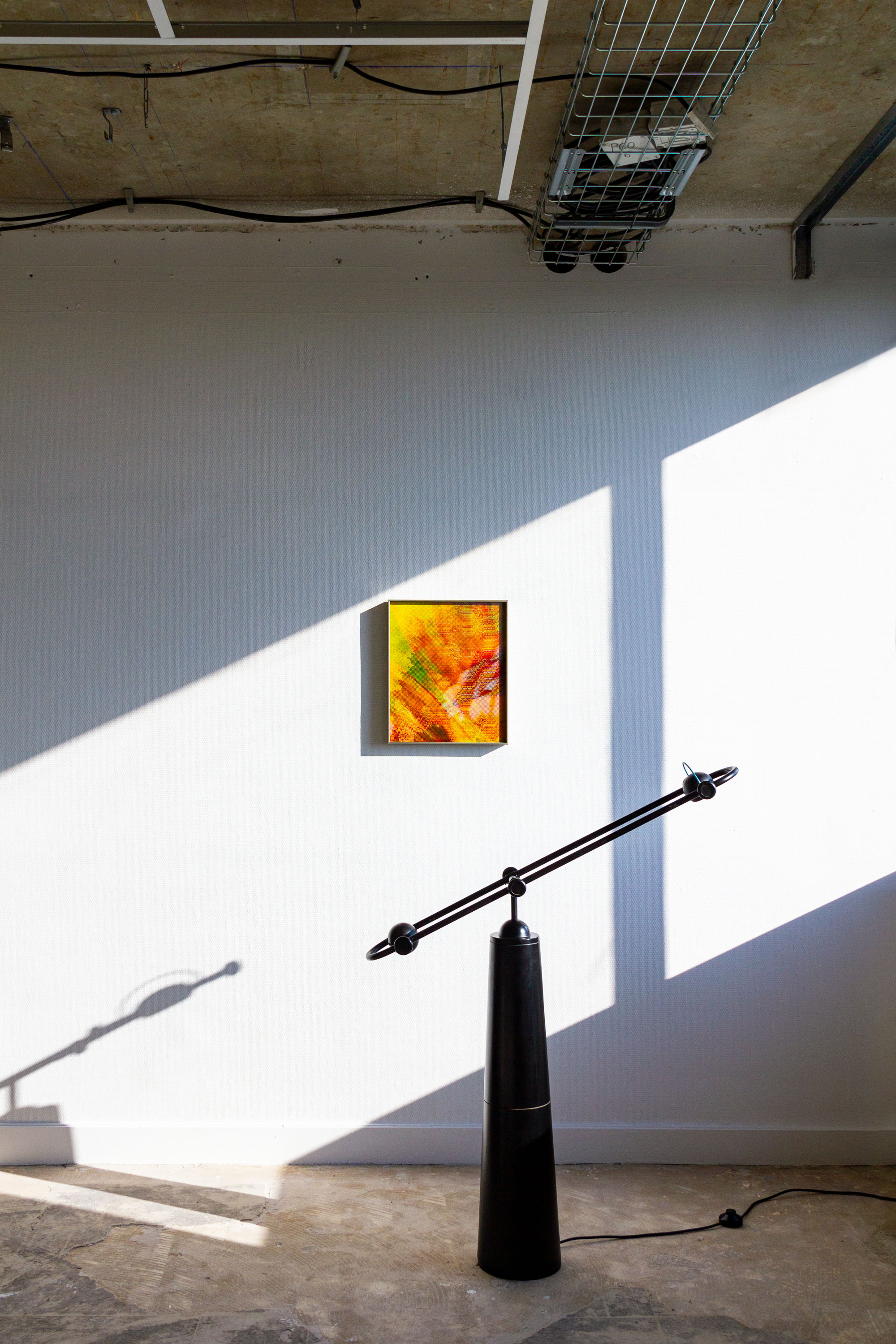
To create the compositions of the show we used different processes to make a bridge between the Artworks and the Furniture. The first, most obvious and probably least intellectually relevant one, was based on colors and shapes associations to create visually striking images. This can easily be seen on the image of Blue Screen and Jean-Louis Godivier’s lounge chair.
—
Pour créer les différentes compositions de cette exposition nous avons utilisé divers processus d’associations pour créer un pont entre les œuvres d’Art et le mobilier. Le premier, à la fois le plus évident et le moins significatif, se base sur des associations de couleurs ou de formes pour créer un effet visuel fort. Cela se ressent par exemple dans la juxtaposition de Blue Screen et de la banquette de Jean-Louis Godivier.
—
• Mathieu Merlet Briand, #SUNFLOWER study I, 2020. • Ronald-Cecil Sportes, Lampe Elysée, Ca. 1983, Ed. Verre Lumière.
–––––
But this goes way further, the main common ground between Mathieu’s work and the pieces that I defend is Science-Fiction. All the Furniture pieces exhibited here could come from a different time, planet, or simply out of the set of a Science-Fiction movie and serve a different purpose than what they were designed for. Therefore, Mathieu’s Green Screen could just refer to the green screen used in cinema to create special effects, the Ronald-Cecil Sportes Lamp then just being a machine gun turret waiting for an attack. And it’s no secret that Philippe Starck’s main influence was Philip K. Dick, who imagined, through his novels, dystopic technology-filled societies. We can relate this idea to the fact that 80s Furniture is not the most functional kind of furniture and can in a way turn against its users. Ironically Mathieu’s big monochromes refer to the main internet bugs that can be faced, for instance the Blue Screen of Death which also shows how technological progress can turn against its users. The SCREEN series also refers to the bug of our modern society and can be relevant considering the current events we are facing and what led us to this project.
—
Mais cela va bien plus loin, le principal dénominateur commun entre les œuvres de Mathieu et le Design que je défends est la Science-Fiction. Toutes les pièces de mobilier présentées ici semblent venir d’un autre temps, d’une autre planète ou tout droit sorties d’un film de Science-Fiction, remplissant ainsi une autre fonction que celle pour laquelle elles ont été pensées. En partant de ce postulat, le Green Screen de Mathieu pourrait être une référence à l’écran vert utilisé pour les effets spéciaux au cinéma, la lampe de Ronald-Cecil Sportes serait alors une tourelle se préparant à une attaque. De plus, l’une des principales influences de jeunesse de Philippe Starck est Philip K. Dick qui a imaginé à travers ses romans, des sociétés dystopiques contrôlées par la technologie. Cette idée se retrouve dans le mobilier 80, celui-ci n’ayant pas la fonctionnalité comme principale caractéristique, peut se retourner contre ses utilisateurs. Ironiquement, les grands monochromes de Mathieu font référence aux principaux bugs informatiques qui peuvent être rencontrés, par exemple le Blue Screen of Death qui traduit également un retournement de la technologie contre son utilisateur. Plus généralement, la série des Screen évoque le « bug » de notre société moderne ce qui fait sens lorsque l’on considère le contexte actuel nous ayant conduit à ce projet.
—• Mathieu Merlet Briand, #BLUE-SCREEN, 2018. • Jean-Louis Godivier, Banquette, Ca. 1987.
–––––
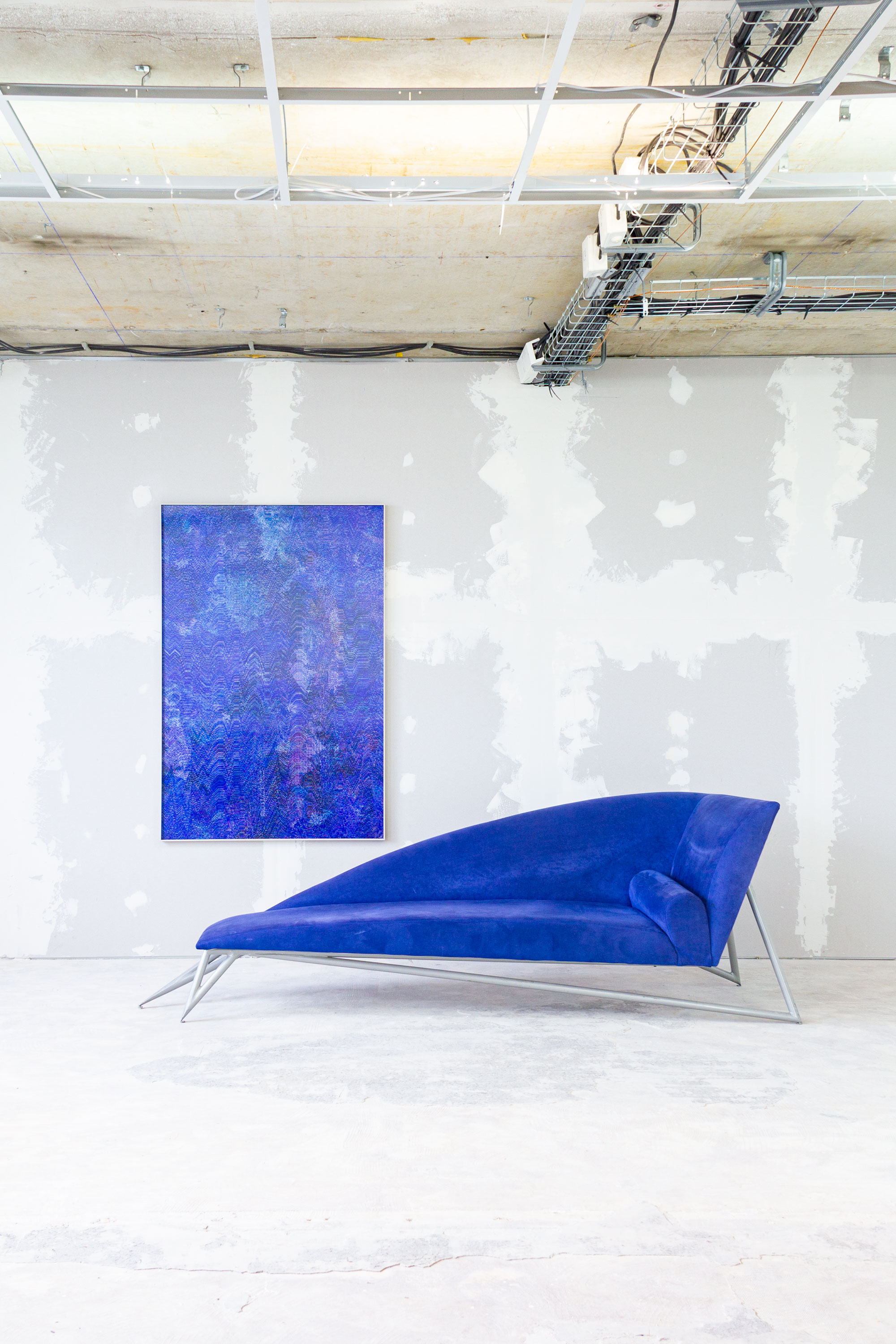
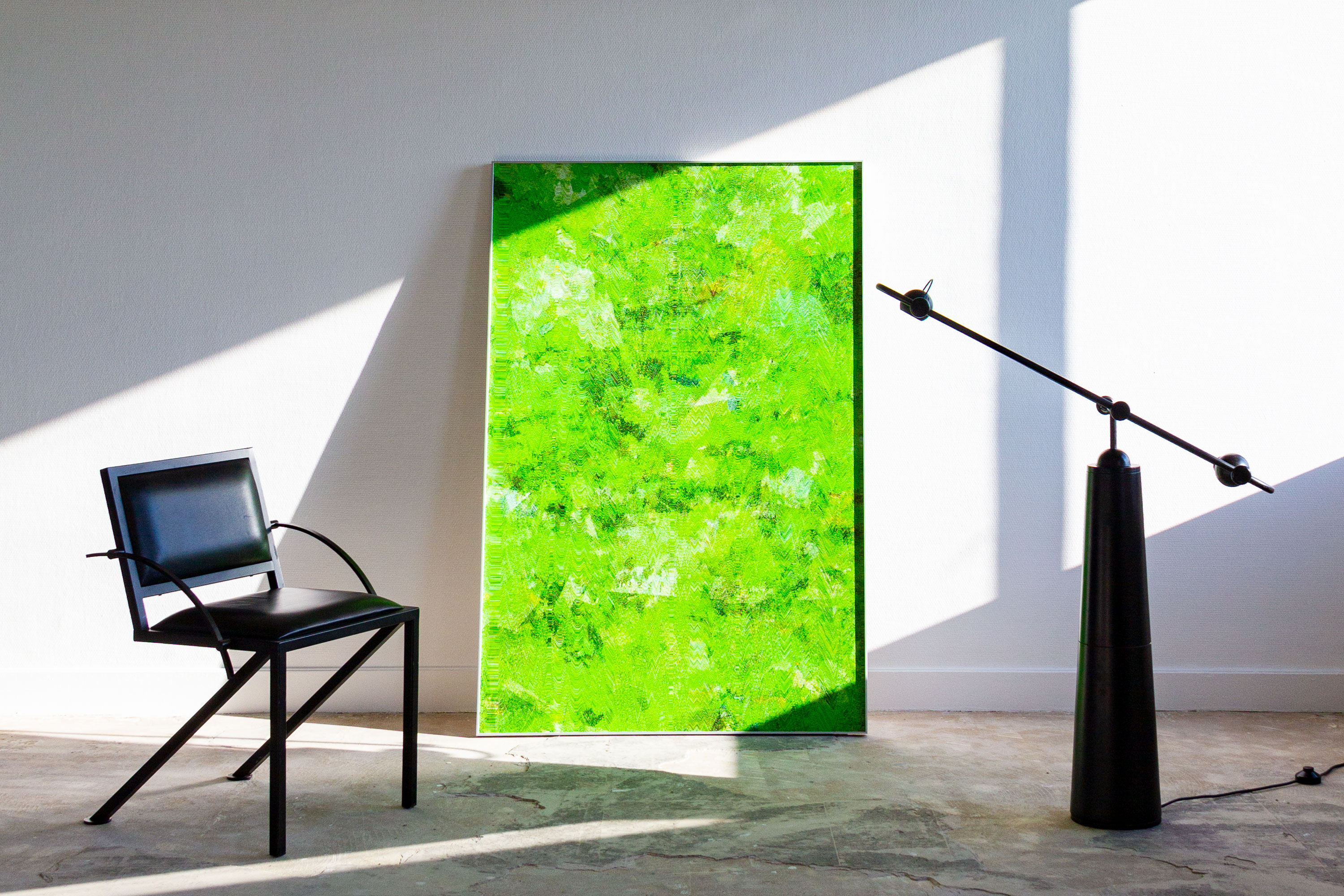
• Mathieu Merlet Briand, #GREEN-SCREEN, 2018.
• Jean-Michel Wilmotte, Fauteuil Compas, Ca. 1984, Ed. Academy.
• Ronald-Cecil Sportes, Lampe Elysée, Ca. 1983, Ed. Verre Lumière.
–––––
The third and last point that is interesting to point out is movement and mainly as seen through a camera lens. Mathieu’s works are moving and changing depending on where the viewer stands while looking at them. If you come closer, if you move to the right or to the left, the abstraction changes. Unfortunately, this cannot be seen on photos. On the other hand, the furniture pieces are perfectly static in real life, but the dynamic of their lines could make you feel the opposite on the images. Somehow the Jean-Louis Godivier lounge chair looks like its walking, trying to escape the scene.
—
Le troisième et dernier point qu’il est intéressant de relever est le mouvement, principalement vu à travers l’objectif d’un appareil photo. Les œuvres de Mathieu sont en mouvement et changent en fonction de la position du regardeur. S’il s’approche, s’il se déplace à droite ou à gauche, l’abstraction change. Malheureusement cela n’est pas perceptible en photo. En revanche les pièces de mobilier sont parfaitement statiques dans le réel, mais la dynamique de leurs lignes peut faire penser le contraire en photo. Si bien que la banquette de Jean-Louis Godivier semble se déplacer, tentant de fuir la scène.
—• Mathieu Merlet Briand, Colonne, 2012.
• Nemo, Chaises Faizzz, Ca. 1982, Ed. Tébong.
–––––
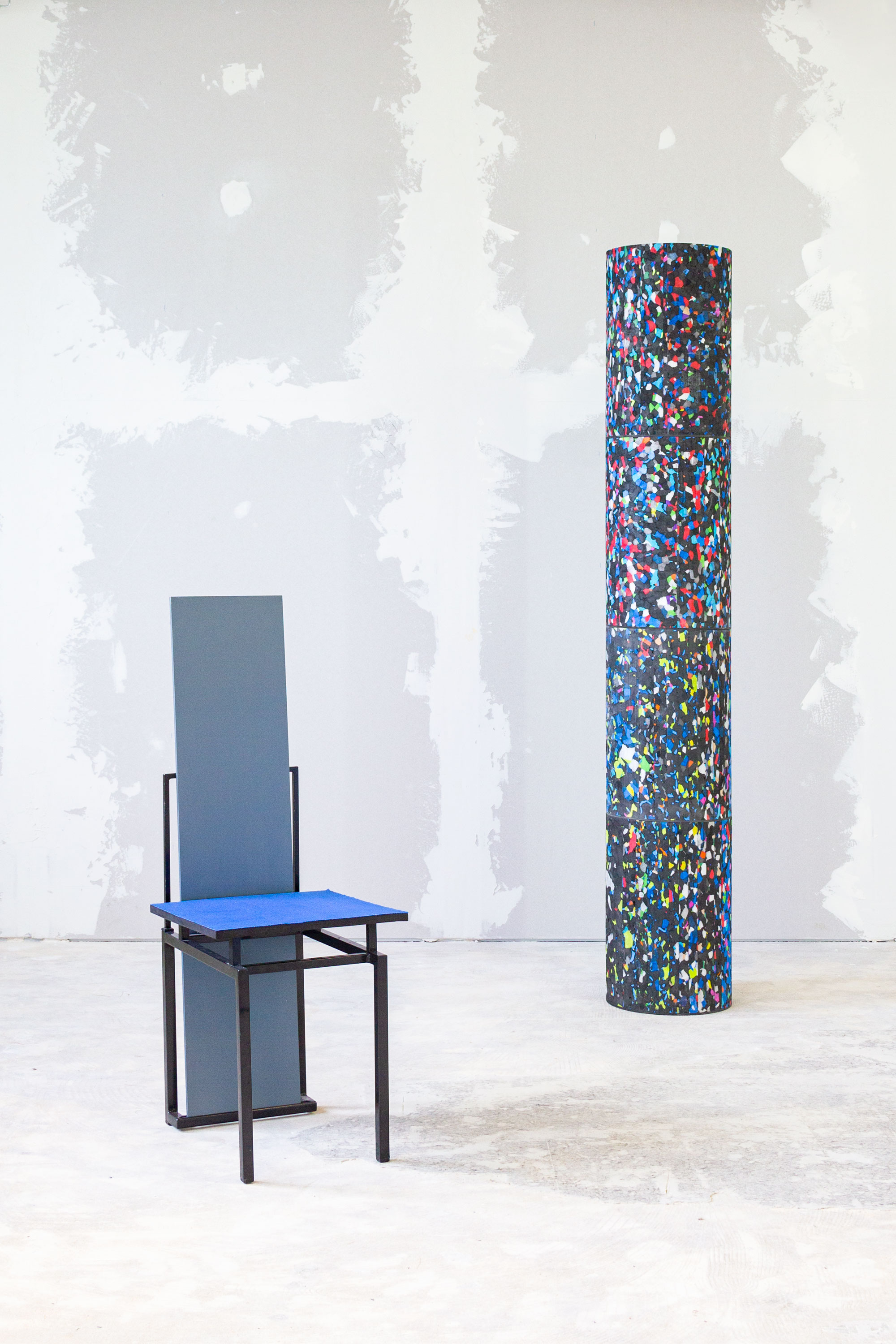
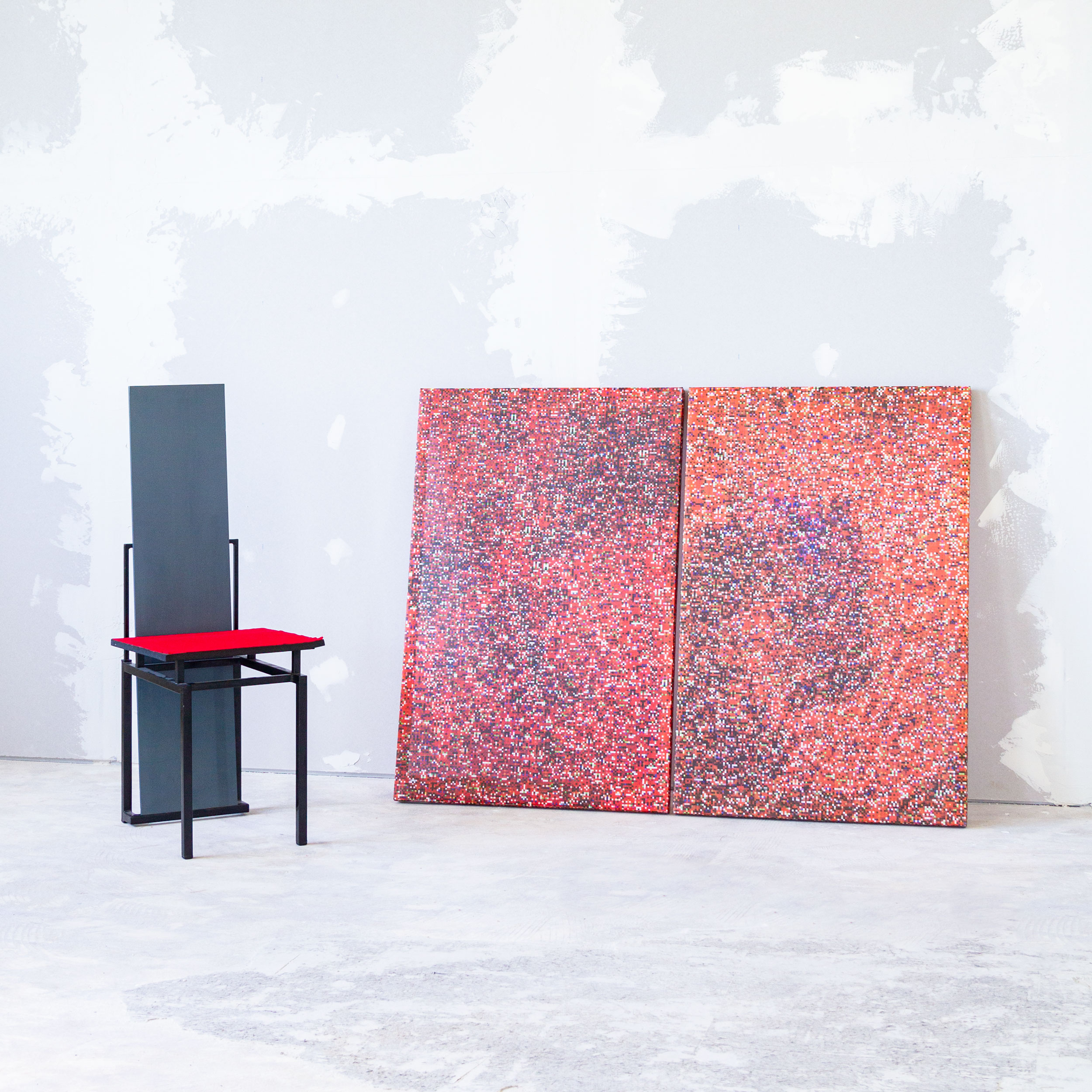
• Mathieu Merlet Briand, Memories of the #RED-SCREEN Temple x 2, 2018.
• Nemo, Chaises Faizzz, Ca. 1982, Ed. Tébong.
–––––

Most of the pieces featured on the photos are available for sale, unless it’s too late.
—
La majorité des pièces présentées dans cette exposition sont disponibles à la vente, à moins qu’il ne soit trop tard.
—
Paul Bourdet
• Mathieu Merlet Briand, #BLUE-SCREEN, 2018. • Jean-Michel Wilmotte, Fauteuil Compas, Ca. 1984, Ed. Academy.
• Mathieu Merlet Briand, Colonne, 2012.
–––––
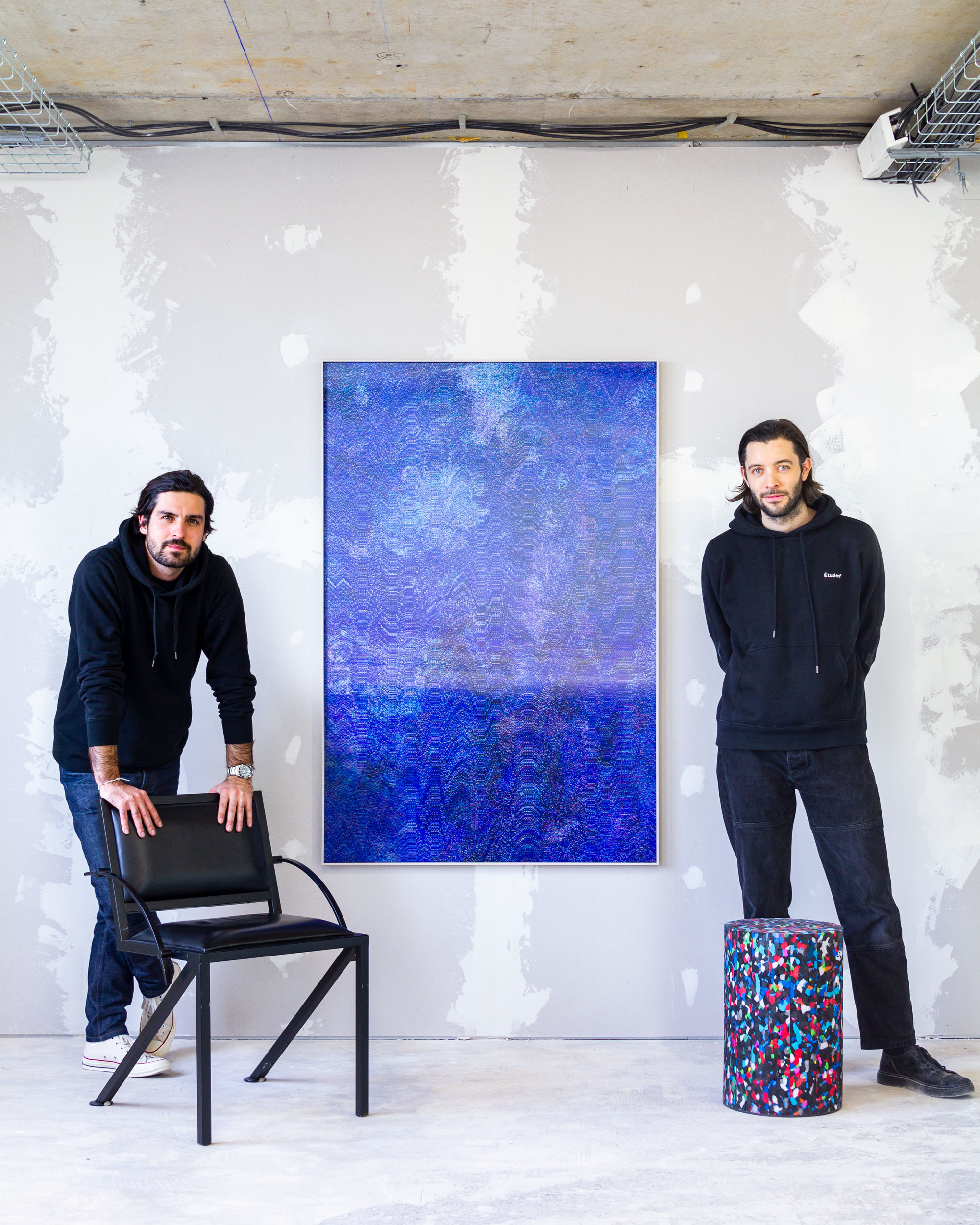
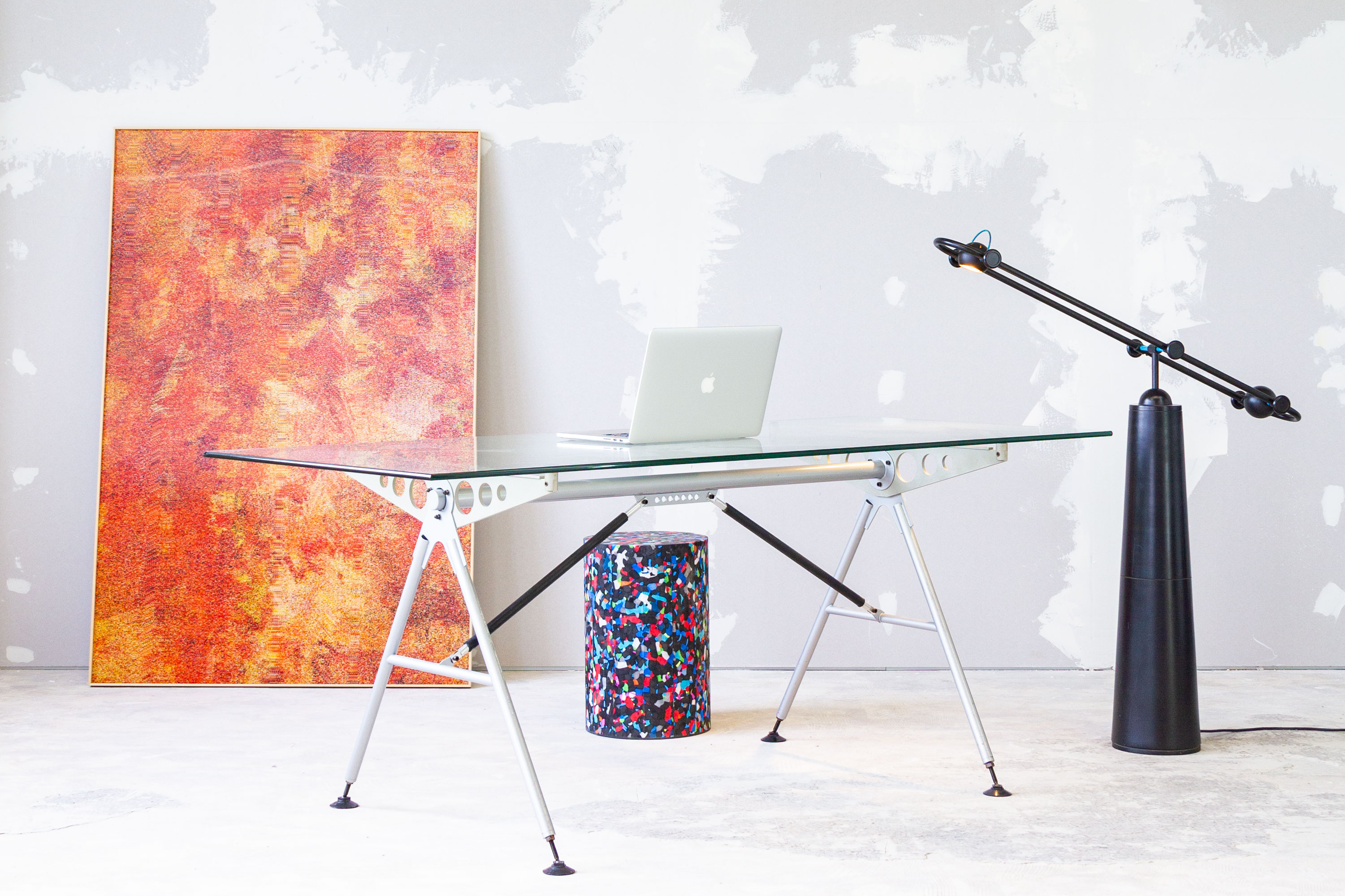
Photo by Mathieu Merlet Briand
—• Mathieu Merlet Briand, #ORANGE-SCREEN, 2018.
• Xavier Matégot, Table XM, Ca. 1986, Ed. Christian Farjon.
• Mathieu Merlet Briand, Colonne, 2012.
• Ronald-Cecil Sportes, Lampe Elysée, Ca. 1983, Ed. Verre Lumière.
–––––
Inspirations
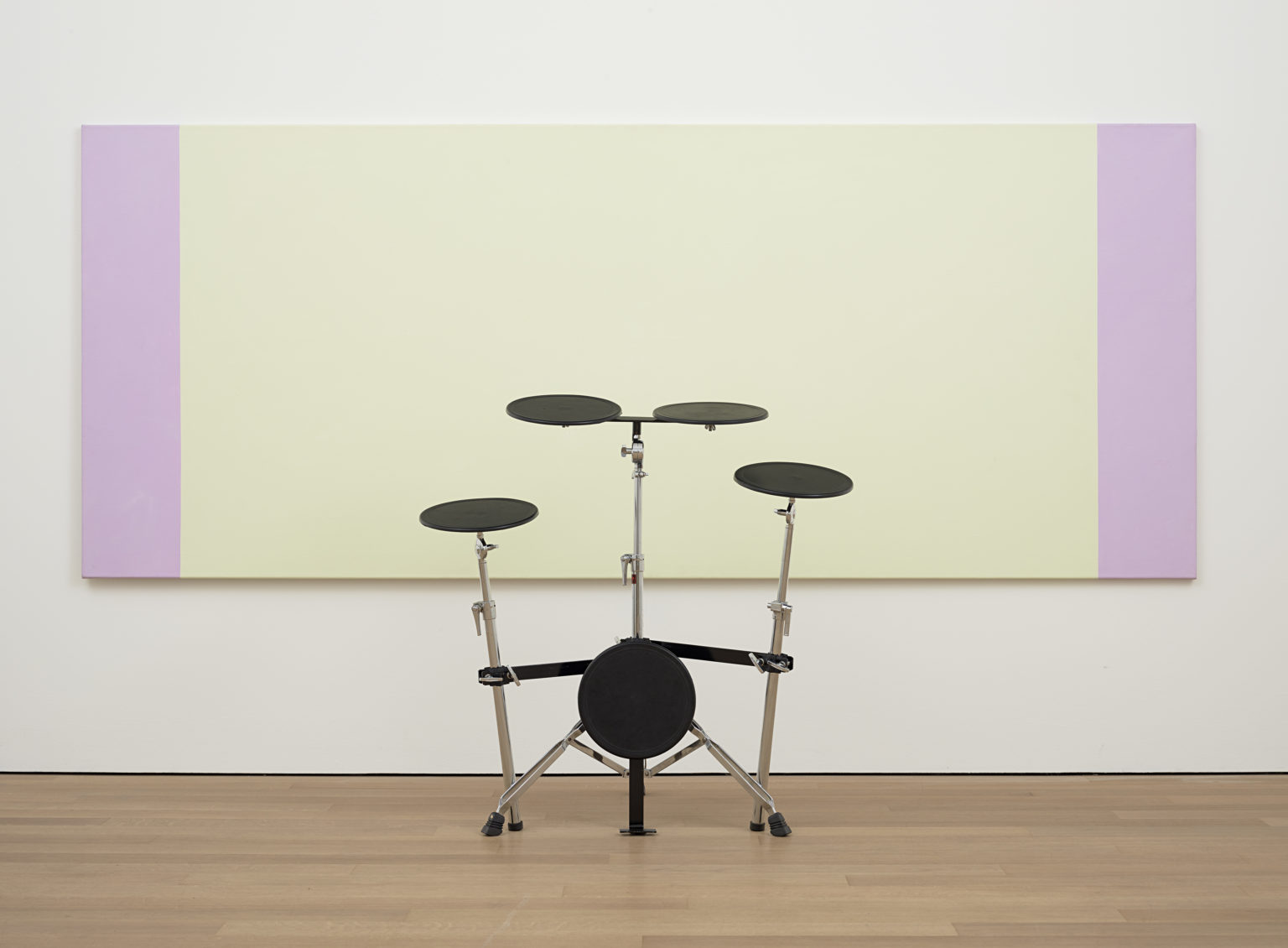 John M. Armleder, Furniture Sculpture 189, 1988.
+
John M. Armleder, Furniture Sculpture 189, 1988.
+
Furniture Sculpture, 1980s
“John M Armleder, after having been immersed in the alternative movement of Fluxus, questioned, from the beginning of the 1980s, abstraction and the idea of modernity through appropriation and quotation.” +
 Joseph Kosuth, One and Three Chairs, 1965.
+
Joseph Kosuth, One and Three Chairs, 1965.
+“In the words of Joseph Kosuth, a display is an arrangement allowing for the creation of ‘dynamic motions between a work’s conceptual integrity and the surplus of meaning born from the associations and montages.’” +
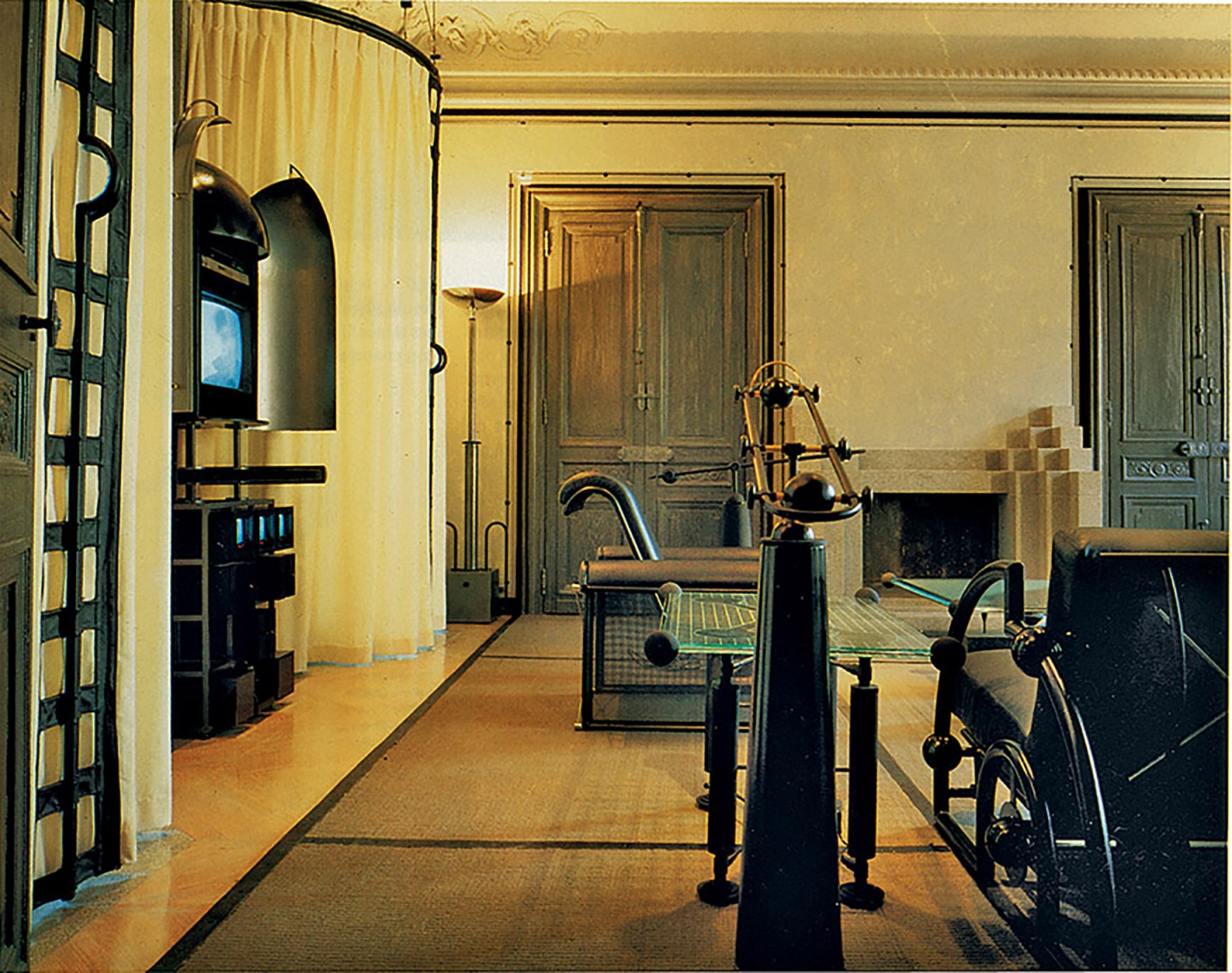 President François Mitterrand's private apartment, Palais de l'Élysée, Paris, ca. 1984 by Ronald-Cecil Sportes.
+
President François Mitterrand's private apartment, Palais de l'Élysée, Paris, ca. 1984 by Ronald-Cecil Sportes.
+ Mathieu Merlet Briand in his studio during the first lockdown, seated on his Philippe Starck chair, Von Vogelsang, ca. 1984, and in front of his work #BLUE-SCREEN, 2018.
Mathieu Merlet Briand in his studio during the first lockdown, seated on his Philippe Starck chair, Von Vogelsang, ca. 1984, and in front of his work #BLUE-SCREEN, 2018.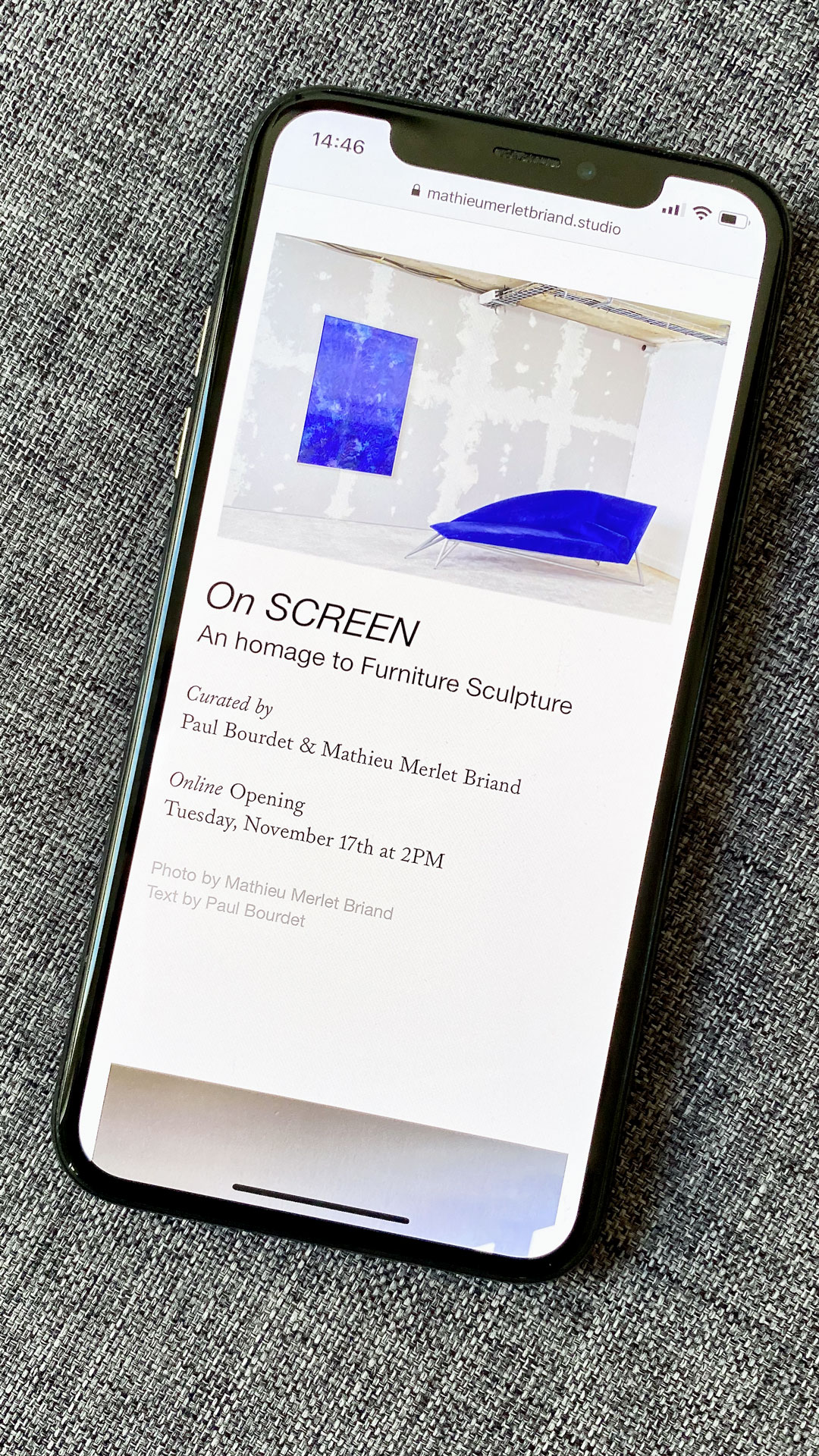
CONTACT ︎
mathieumerletbriand.news@gmail.com
© Mathieu Merlet Briand studio


 Blue Screen of Death (BSoD)
Blue Screen of Death (BSoD) Total Recall, Paul Verhoeven, 1990, with 80s Starck furniture. Sci-Fi movie based on the Philip K. Dick short story “We Can Remember It for You Wholesale” 1966.
Total Recall, Paul Verhoeven, 1990, with 80s Starck furniture. Sci-Fi movie based on the Philip K. Dick short story “We Can Remember It for You Wholesale” 1966.
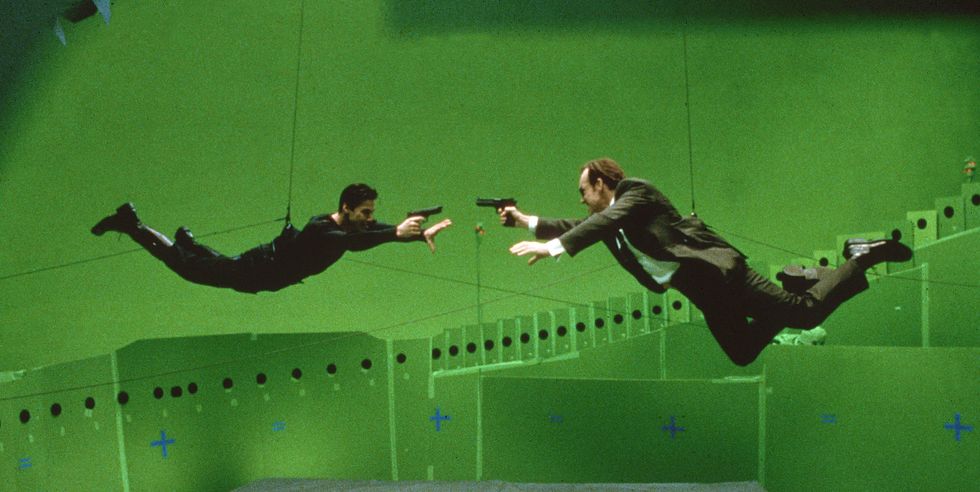 Chroma Key, Green Screen special effect, making of the Sci-Fi movie Matrix.
Chroma Key, Green Screen special effect, making of the Sci-Fi movie Matrix.